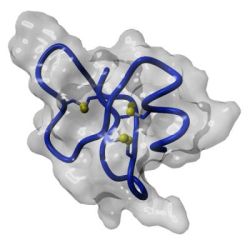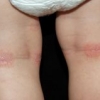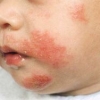IL-33 modula l'espressione della beta defensina 2 umana nei cheratinociti umani primari e può influenzare la suscettibilità alla superinfezione batterica nella dermatite atopica acuta
 L'IL-33 è un membro della famiglia dell'IL-1 ed è stata implicata nelle malattie allergiche sostenute dai Th2, come la dermatite atopica e l'asma.
L'IL-33 è un membro della famiglia dell'IL-1 ed è stata implicata nelle malattie allergiche sostenute dai Th2, come la dermatite atopica e l'asma.
La più importante citochina Th2, l'IL-4, trovata altamente espressa nell'eczema allergico acuto, è nota per sotto-regolare l'espressione della beta defensina 2 umana (hBD2) nei cheratinociti umani, e questo fenomeno è associato con le super-infezioni nei pazienti affetti dalla dermatite atopica.
Abbiamo studiato l'effetto di IL-33 sull'espressione di hBD2 nei cheratinociti umani. La produzione di hBD2 da parte dei cheratinociti stimolati è stato misurata mediante la tecnica ELISA.
I risultati hanno mostrato che il siero è un induttore molto potente di hBD2 e che il 2.5% del siero umano è stato molto più potente nell'indurre hBD2 rispetto a 20 ng/ml di TNFα. È interessante notare che, il siero da pazienti affetti da dermatite atopica ha mostrato una ridotta capacità di indurre hBD2 nei cheratinociti normali. IL-33 ha significativamente sotto-regolato la hBD2 indotta dal siero. La capacità sotto-regolatoria dell'IL-33 è risultata essere da 1.5 a 2 volte più debole rispetto all'IL-4.
I nostri dati suggeriscono che l'IL-33 può contribuire significativamente a diminuire l'espressione di hBD2 nella reazione eczematosa acuta caratterizzata clinicamente da un aspetto spongioso e con trasudano — indicativa, per questo motivo, del contatto dell'epidermide con le componenti del siero.
Storia della pubblicazione:
Titolo: IL-33 Modulates the Expression of Human Beta Defensin 2 in Human Primary Keratinocytes and may influence the susceptibility to bacterial superinfection in acute atopic dermatitis.
Rivista: British Journal of Dermatology. doi: 10.1111/j.1365-2133.2012.11140.x
Autori: A. Alase, J. Seltmann, T. Werfel, M. Wittmann
Affiliazioni: Leeds Institute of Molecular Medicine, Division of Rheumatic and Musculoskeletal Disease, University of Leeds, UK
Centre for Skin Sciences, School of Life Sciences, University of Bradford
Division of Immunodermatology and Allergy Research, Department of Dermatology, Hannover Medical School, Germany.
Abstract:
IL-33 is a member of the IL-1 family and has been implicated in Th2 driven allergic diseases such as atopic dermatitis and asthma. The principal Th2 cytokine IL-4, found highly expressed in acute allergic eczema, is known to downregulate human beta defensin 2 (hBD2) expression in human keratinocytes and this is associated with super-infection in patients suffering from atopic dermatitis.
We investigated the effect of IL-33 on the expression of hBD2 in human keratinocytes. hBD2 production by stimulated keratinocytes was measured by ELISA.
Our results showed that serum is a very potent inducer of hBD2 and 2.5% of human serum were much more potent in inducing hBD2 than 20 ng/ml of TNFα. Interestingly, serum of atopic dermatitis patients showed an impaired ability to induce hBD2 in normal keratinocytes. IL-33 significantly downregulated serum induced hBD2. The downregulatory capacity of IL-33 was found to be 1.5 to 2 fold weaker compared with IL-4.
Our data suggest that IL-33 can significantly contribute to the decreased expression of hBD2 in acute eczematous reaction clinically characterised by spongiosis and oozing — thus indicative for contact of the epidermis with serum components.
https://www.youtube.com/@djfdm




